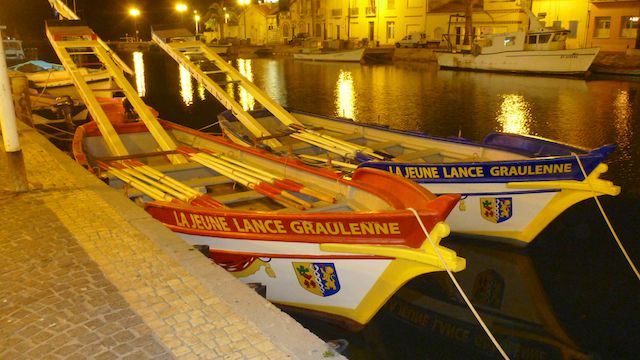CAMARGUE
Part Two
Part Two
Our sometimes travel companions, the Lucases, joined us on our second trip this year to the Camargue.
 |
| fishing boats at Le Grau-du-Roi |
We returned to Mas St Louis, the same Chambres d’Hôtes where we stayed a few weeks earlier. François and his friend Robert welcomed our return.
We shared the upper floor two-bedroom suite where we occasionally did our own cooking. More often, we prepared our meals at the al fresco kitchen.
The daily swim in the pool was rather refreshing. While it was too cold for the locals, I assured François that we Canadians found it quite tolerable.


Mas St Louis is only about 5 minutes by car to the ancient city of Aigues-Mortes, one of the most popular centres in the Camargue.
aigues-mortes
means dead waters.
means dead waters.
The Camargue is the delta of the Rhone River and it consists of lakes, lagoons, marshes, rivers and canals.
Salt production began here as far back as antiquity. The Romans engineered works to create a widespread and consistent supply. Today, SALINS produces salt using thousands of hectares of pools and land, stretching from 18 kilometres east-west and 13.5 km north-south. In the brochure, one reads that this is about the same area as Paris.
THE PROCESS:
1. In early spring, ponds are filled with salt water and are trapped there.
3. From April to September crystallization forms salt cakes up to 9 mm thick.
4. September is harvest month when salt cakes are lifted from the ground and trucked to the plant.
Looking out onto the salt fields in the fall, one can see the pink tint of crystals. This entire area is a protected wildlife heritage with very unique biodiversity. Flamingoes are only one of many birds that thrive here.
Q: Why are flamingoes pink?
A: One of their major food sources is brine shrimp and their colour turns the birds' feathers pink.
The statue of Saint Louis dominates the central square.
(sorry, no photo)
King Louis lX spent much time here and had a lot to do with the development of this area of France up until his death in 1270.
Louis was the only canonized French king, better known as Saint Louis. He has been much lionized throughout history, however, among his less celebrated deeds was his leadership role in the annihilation of the Cathars and his creation of the French Inquisition. The 13th century was a very dark time in the history of this part of the world.
The other two not-to-be-missed towns in the Camargue are Le Grau-du-Roi, 5 minutes drive to the west, and in the Camargue National Park, Les Saintes-Maries-de-la-Mer about 30 minutes to the east of Aigues Mortes.
These places are well worth visiting. The Camargue is a very unique region of the European continent. This vast delta of the Rhone is like nowhere else in France. The fascinating history and geographical diversity of the area, the flora and fauna, and the agriculture that yields a richness of local wines and foods will all delight the traveller. And there is no shortage of opportunities here for watersports or just plain relaxation on the sandy beaches of the Mediterranean.
NOTE: one might avoid coming to the Camargue in July or August when the rest of France is here. Even in September, there are plenty of tour buses from almost everywhere in Europe.
 |
| les taurines (bulls) are raised for the arena ... and saucisson |
 |
Camargue ponies are people-friendly, especially to people like our good friend, Colleen. |
 |
| harbour at Le Grau-du-Roi For more travel photography with local information visit my website. Gary Karlsen's photography website |











No comments:
Post a Comment